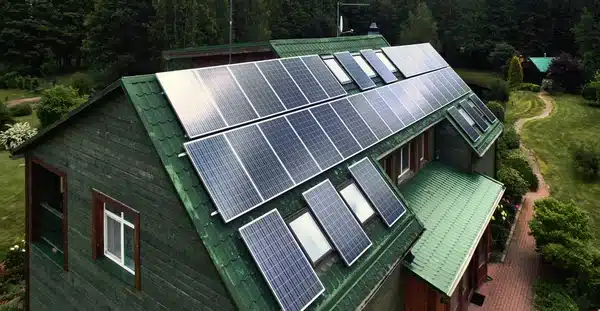
Solar Panel: A device that converts sunlight into electricity.
Photovoltaic (PV): The technology used to convert sunlight into electrical energy.
Inverter: Equipment that converts DC electricity from solar panels to AC electricity.
Solar Cells: Individual units within a solar panel that convert sunlight into electricity.
Grid-Tied System: A solar installation that is connected to the utility electrical grid.
Off-Grid System: A solar installation not connected to the utility grid, often using batteries for storage.
Net Metering: A billing mechanism that allows solar panel owners to sell excess electricity back to the grid.
Solar Array: A collection of multiple solar panels connected together.
Kilowatt-hour (kWh): Unit of energy commonly used to measure electricity usage.
Watt (W): Unit of electrical power.
Mounting System: The structure used to attach solar panels to a surface like a roof or ground.
Energy Storage: Devices like batteries are used to store excess solar energy.
Charge Controller: Device that manages the charging and discharging of solar batteries.
Micro-Inverter: A small inverter for a single solar panel, as opposed to a string or central inverter that serves multiple panels.
Solar Efficiency: The ratio of energy output from the solar cell to input energy from the sun.
Interconnection: The technical and legal process of connecting a solar system to the electrical grid.
Solar Irradiance: The power per unit area received from the sun in the form of electromagnetic radiation.
Monocrystalline: A type of solar cell made from a single crystal structure, usually more efficient but expensive.
Polycrystalline: A type of solar cell made from multiple crystal structures, usually less efficient but cheaper.
Thin-Film: A type of solar cell made by depositing one or more thin layers of photovoltaic material.
DC-AC Conversion: The process of converting Direct Current to Alternating Current.
String Inverter: An inverter serving a string of multiple solar panels.
Solar Coefficient: Measures how much panel efficiency decreases as temperature increases.
Solar Insolation: Measure of solar power received per unit area at a particular location.
Stand-Alone System: A solar system that operates independently of the utility grid.
Utility-Scale Solar: Large solar installations designed to provide power to the electrical grid.
Renewable Energy Credits (RECs): Certificates that represent the environmental benefits of renewable energy production.
Feed-In Tariff: Payments to ordinary energy users for the renewable electricity they generate.
Power Purchase Agreement (PPA): A contract to buy the electricity generated by a solar system.
Peak Load: The highest level of electricity demand in a given period.
Tilt Angle: The angle at which a solar panel is set to maximize its exposure to the sun.
Azimuth Angle: The compass direction in which the solar panels are pointed.
Balance of System (BOS): All supporting components of a solar system excluding the solar panels themselves.
Solar Tracker: Mechanism that moves solar panels to follow the sun.
Optimized Inverter: An inverter with maximum power point tracking (MPPT) to optimize power extraction from solar panels.
Islanding: A condition where a solar system continues to power a location even though electrical grid power is unavailable.
Open-Circuit Voltage (Voc): The maximum possible voltage across a solar cell.
Short-Circuit Current (Isc): The maximum possible current through a solar cell.
Maximum Power Point (MPP): The point at which a solar cell produces the most power.
Levelized Cost of Electricity (LCOE): The per-unit cost of electricity over the solar system’s lifetime.
Solar Access Laws: Laws that protect a homeowner’s right to access sunlight for solar energy use.
Hybrid System: A solar installation combined with another form of electricity generation, often wind or a generator.
Solar Canopy: A structure with solar panels that serves as a shade structure as well, often over parking lots.
Building-Integrated Photovoltaics (BIPV): Solar panels integrated into the building material itself, such as solar windows or solar roofs.
Energy Audit: An assessment to evaluate energy use and identify cost-effective options to reduce energy consumption and costs.
Performance Ratio: Compares the actual output of a solar system to its theoretical maximum output.
Capacity Factor: The ratio of the actual energy output to the maximum possible output over a certain period.
String: A series of solar panels connected in sequence.
Inverter Clipping: A situation where the inverter cannot convert all the DC power it is receiving into AC power, usually because it’s receiving more power than its rated capacity.
Shading Analysis: An evaluation to determine how much shade may fall on a solar panel, affecting its efficiency.
